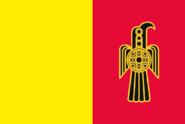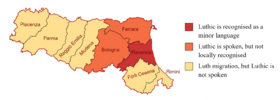Luthic: Difference between revisions
Lëtzelúcia (talk | contribs) m (typo) |
Lëtzelúcia (talk | contribs) m (Lore: Gothic Luthic) |
||
| Line 37: | Line 37: | ||
==Classification== | ==Classification== | ||
[[File:Romance-lg-classification Luthic.png|thumb | [[File:Romance-lg-classification Luthic.png|thumb|Chart of Romance languages based on structural and comparative criteria, not on socio-functional ones. FP: Franco-Provençal, IR: Istro-Romanian.]] | ||
Luthic is an [[w:Indo-European languages|Indo-European language]] that belongs to the Gotho-Romance group of the Italic languages, however Luthic has great Germanic influence; where the [[w:Germanic languages|Germanic languages]] are traditionally subdivided into three branches: [[w:North Germanic languages|North Germanic]], [[w:East Germanic languages|East Germanic]], and [[w:West Germanic languages|West Germanic]]. The first of these branches survives in modern [[w:Danish language|Danish]], [[w:Swedish language|Swedish]], [[w:Norwegian language|Norwegian]], [[w:Elfdalian language|Elfdalian]], [[w:Faroese language|Faroese]], and [[w:Icelandic language|Icelandic]], all of which are descended from [[w:Old Norse language|Old Norse]]. The East Germanic languages are now extinct, and [[w:Gothic language|Gothic]] is the only language in this branch which survives in written texts; Luthic is the only surviving Indo-European language with extensive East Germanic derived vocabulary. The West Germanic languages, however, have undergone extensive dialectal subdivision and are now represented in modern languages such as [[w:English language|English]], [[w:German language|German]], [[w:Dutch language|Dutch]], [[w:Yiddish language|Yiddish]], [[w:Afrikaans language|Afrikaans]], and others. | Luthic is an [[w:Indo-European languages|Indo-European language]] that belongs to the Gotho-Romance group of the Italic languages, however Luthic has great Germanic influence; where the [[w:Germanic languages|Germanic languages]] are traditionally subdivided into three branches: [[w:North Germanic languages|North Germanic]], [[w:East Germanic languages|East Germanic]], and [[w:West Germanic languages|West Germanic]]. The first of these branches survives in modern [[w:Danish language|Danish]], [[w:Swedish language|Swedish]], [[w:Norwegian language|Norwegian]], [[w:Elfdalian language|Elfdalian]], [[w:Faroese language|Faroese]], and [[w:Icelandic language|Icelandic]], all of which are descended from [[w:Old Norse language|Old Norse]]. The East Germanic languages are now extinct, and [[w:Gothic language|Gothic]] is the only language in this branch which survives in written texts; Luthic is the only surviving Indo-European language with extensive East Germanic derived vocabulary. The West Germanic languages, however, have undergone extensive dialectal subdivision and are now represented in modern languages such as [[w:English language|English]], [[w:German language|German]], [[w:Dutch language|Dutch]], [[w:Yiddish language|Yiddish]], [[w:Afrikaans language|Afrikaans]], and others. | ||
| Line 43: | Line 43: | ||
Luthic has been influenced by [[w:Italian language|Italian]], [[w:Frankish language|Frankish]], [[w:Gothic language|Gothic]] and [[w:Lombardic language|Langobardic]] since its first attestation, the great influence of these languages on the vocabulary and grammar of Modern Luthic is widely acknowledged. Most specialists in [[w:Language contact|language contact]] do consider Luthic to be a [[w:Mixed language|true mixed language]]. Luthic is classified as a Romance langauge because it shares innovations with other Romance languages such as Italian, French and Spanish. | Luthic has been influenced by [[w:Italian language|Italian]], [[w:Frankish language|Frankish]], [[w:Gothic language|Gothic]] and [[w:Lombardic language|Langobardic]] since its first attestation, the great influence of these languages on the vocabulary and grammar of Modern Luthic is widely acknowledged. Most specialists in [[w:Language contact|language contact]] do consider Luthic to be a [[w:Mixed language|true mixed language]]. Luthic is classified as a Romance langauge because it shares innovations with other Romance languages such as Italian, French and Spanish. | ||
==History== | |||
The Luthic [[w:Philology|philologist]] Aþalphonso Silva divided the history of Luthic into a period from 500 AD to 1740 to be "Mediaeval Luthic", which he subdivided into “Gothic Luthic” (500–1100), “Mediaeval Luthic” (1100–1600) and “late Mediaeval Luthic” (1600–1740). | |||
===Gothic Luthic=== | |||
The earliest varieties of a Luthic language, collectively known as ''Gothic Luthic'' or “''Gotho-Luthic''”, evolved from the contact of [[w:Vulgar Latin|Latin dialects]] and East Germanic languages. A considerable amount of East Germanic vocabulary was incorporated into Luthic over some five centuries. Approximately 1,200 uncompounded Luthic words are derived from Gothic and ultimately from [[w:Proto-Indo-European language|Proto-Indo-European]]. Of these 1,200, 700 are nouns, 300 are verbs and 200 are adjectives. Luthic has also absorbed many loanwords, most of which were borrowed from West Germanic languages of the [[w:Early Middle Ages|Early Middle Ages]]. | |||
Only a few documents in Gothic Luthic have survived – not enough for a complete reconstruction of the language. Most Gothic Luthic-language sources are translations or glosses of other languages (namely, [[w:Koine Greek|Greek]] and [[w:Latin language|Latin]]), so foreign linguistic elements most certainly influenced the texts. Nevertheless, Gothic Luthic was probably very close to Gothic (it is known primarily from the [[w:Codex Argenteus|Codex Argenteus]], a 6th-century copy of a 4th-century [[w:Bible|Bible]] translation, and is the only East Germanic language with a sizeable [[w:Text corpus|text corpus]]). These are the primary sources: | |||
:* ''Codex Luthicus'' (Ravenna), two parts: 87 leaves | |||
::It contains scattered passages from the New Testament (including parts of the gospels and the Epistles), from the Old Testament (Nehemiah), and some commentaries. The text likely had been somewhat modified by copyists. It was written using the [[w:Gothic alphabet|Gothic alphabet]], an alphabet used for writing the Gothic language. It was developed in the 4th century AD by [[w:Ulfilas|Ulfilas]] (or ''Wulfila''), a Gothic preacher of [[w:Cappadocian Greeks|Cappadocian Greek]] descent, for the purpose of [[w:Gothic Bible|translating the Bible]]. | |||
:* ''Codex Ravennas'' (Ravenna), four parts: 140 leaves | |||
::A [[w:Civil code|Civil code]] enacted under [[w:Theodoric the Great|Theodoric the Great]]. The code covered the [[w:Ostrogothic Kingdom|Ostrogothic Kingdom of Italy]], but mainly Ravenna, as Theodoric devoted most of his architectural attention to his capital, Ravenna. Codex Ravennas was also written using the Gothic alphabet. The text likely had been somewhat modified by copyists. Together with four leaves, fragments of Romans 11–15 (a Luthic–Latin diglot). | |||
[[File:Luthiks.png|thumb|Detail of the ''Codex Luthicus'', the word ''Luþiks'' is attested, referring to the Luths]] | |||
Revision as of 22:43, 2 March 2024
| Luthic | |
|---|---|
| Lûthica | |
 Flag of the Luthic-speaking Ravenna | |
| Pronunciation | [ˈlu.tʰi.xɐ] |
| Created by | Lëtzelúcia |
| Date | 2023 |
| Native to | Ravenna; Ferrara and Bologna |
| Ethnicity | Luths |
| Native speakers | 149,500 (2020) |
Indo-European
| |
| Official status | |
Recognised minority language in | Italy (recognised by the Luthic Community of Ravenna) |
| Regulated by | Council for the Luthic Language |
The areas where Luthic (red and orange) is spoken. | |
Luthic (/ˈluːθ.ɪk/ LOOTH-ik, less often /ˈlʌθ.ɪk/ LUTH-ik, also Luthish; endonym: Lûthica [ˈlu.tʰi.xɐ] or Rasda Lûthica [ˈʁaz.dɐ ˈlu.tʰi.xɐ]) is an Italic language that is spoken by the Luths, with strong East Germanic influence. Unlike other Romance languages, such as Portuguese, Spanish, Catalan, Occitan and French, Luthic has a large inherited vocabulary from East Germanic, instead of only proper names that survived in historical accounts, and loanwords. About 250,000 people speak Luthic worldwide.
Luthic is the result of a prolonged contact among members of both regions after the Gothic raids towards the Roman Empire began, together with the later West Germanic merchants’ travels to and from the Western Roman Empire. These connections and the conquest by the Germanic tribes of the Roman Empire slowly formed a creole for mutual communication.
As a standard form of the Gotho-Romance language, Luthic has similarities with other Italo-Dalmatian languages, Western Romance languages and Sardinian. The status of Luthic as the regional language of Ravenna and the existence there of a regulatory body have removed Luthic, at least in part, from the domain of Standard Italian, its traditional Dachsprache. It is also related to the Florentine dialect spoken by the Italians in the Italian city of Florence and its immediate surroundings.
Luthic is an inflected fusional language, with four cases for nouns, pronouns, and adjectives (nominative, accusative, genitive, dative); three genders (masculine, feminine, neuter); and two numbers (singular, plural).
Classification
Luthic is an Indo-European language that belongs to the Gotho-Romance group of the Italic languages, however Luthic has great Germanic influence; where the Germanic languages are traditionally subdivided into three branches: North Germanic, East Germanic, and West Germanic. The first of these branches survives in modern Danish, Swedish, Norwegian, Elfdalian, Faroese, and Icelandic, all of which are descended from Old Norse. The East Germanic languages are now extinct, and Gothic is the only language in this branch which survives in written texts; Luthic is the only surviving Indo-European language with extensive East Germanic derived vocabulary. The West Germanic languages, however, have undergone extensive dialectal subdivision and are now represented in modern languages such as English, German, Dutch, Yiddish, Afrikaans, and others.
Among the Romance languages, its classification has always been controversial, for example, it is one of the Italo-Dalmatian languages and most closely related to Istriot on the one hand and Tuscan-Italian on the other. Some authors include it among the [[w:Gallo-Italic languages|Gallo-Italic languages], and according to others, it is not related to either one. Although both Ethnologue and Glottolog group Luthic into a new language group, the Gotho-Romance (opere citato) family is still somewhat dubious.
Luthic has been influenced by Italian, Frankish, Gothic and Langobardic since its first attestation, the great influence of these languages on the vocabulary and grammar of Modern Luthic is widely acknowledged. Most specialists in language contact do consider Luthic to be a true mixed language. Luthic is classified as a Romance langauge because it shares innovations with other Romance languages such as Italian, French and Spanish.
History
The Luthic philologist Aþalphonso Silva divided the history of Luthic into a period from 500 AD to 1740 to be "Mediaeval Luthic", which he subdivided into “Gothic Luthic” (500–1100), “Mediaeval Luthic” (1100–1600) and “late Mediaeval Luthic” (1600–1740).
Gothic Luthic
The earliest varieties of a Luthic language, collectively known as Gothic Luthic or “Gotho-Luthic”, evolved from the contact of Latin dialects and East Germanic languages. A considerable amount of East Germanic vocabulary was incorporated into Luthic over some five centuries. Approximately 1,200 uncompounded Luthic words are derived from Gothic and ultimately from Proto-Indo-European. Of these 1,200, 700 are nouns, 300 are verbs and 200 are adjectives. Luthic has also absorbed many loanwords, most of which were borrowed from West Germanic languages of the Early Middle Ages.
Only a few documents in Gothic Luthic have survived – not enough for a complete reconstruction of the language. Most Gothic Luthic-language sources are translations or glosses of other languages (namely, Greek and Latin), so foreign linguistic elements most certainly influenced the texts. Nevertheless, Gothic Luthic was probably very close to Gothic (it is known primarily from the Codex Argenteus, a 6th-century copy of a 4th-century Bible translation, and is the only East Germanic language with a sizeable text corpus). These are the primary sources:
- Codex Luthicus (Ravenna), two parts: 87 leaves
- It contains scattered passages from the New Testament (including parts of the gospels and the Epistles), from the Old Testament (Nehemiah), and some commentaries. The text likely had been somewhat modified by copyists. It was written using the Gothic alphabet, an alphabet used for writing the Gothic language. It was developed in the 4th century AD by Ulfilas (or Wulfila), a Gothic preacher of Cappadocian Greek descent, for the purpose of translating the Bible.
- Codex Ravennas (Ravenna), four parts: 140 leaves
- A Civil code enacted under Theodoric the Great. The code covered the Ostrogothic Kingdom of Italy, but mainly Ravenna, as Theodoric devoted most of his architectural attention to his capital, Ravenna. Codex Ravennas was also written using the Gothic alphabet. The text likely had been somewhat modified by copyists. Together with four leaves, fragments of Romans 11–15 (a Luthic–Latin diglot).


